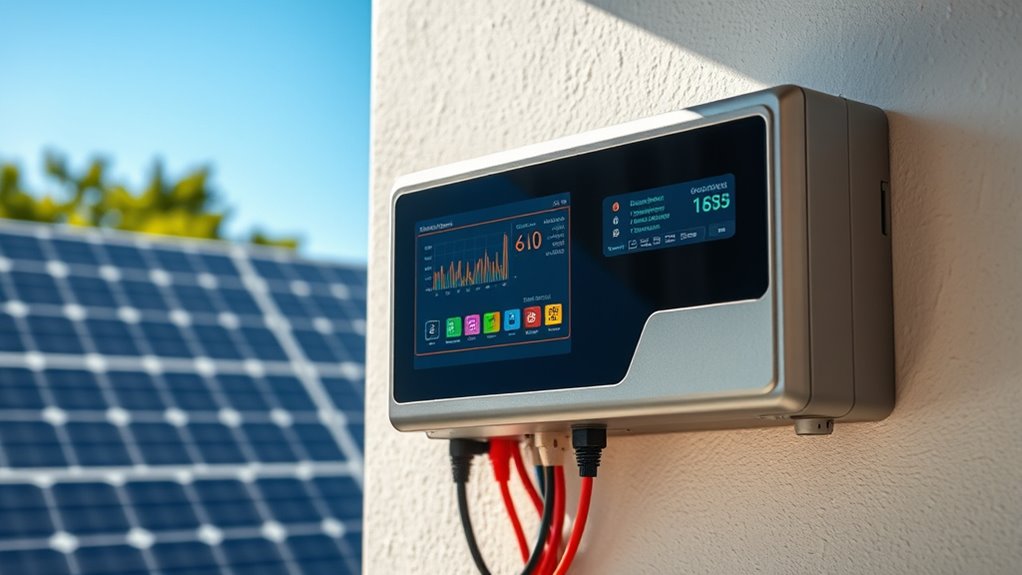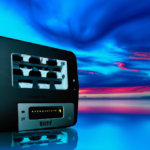To avoid curtailment penalties, you should configure your smart inverter with settings like Volt-Watt and Frequency-Watt modes, which automatically adjust power during voltage or frequency issues. Properly preset curtailment levels and enable local control features help minimize the need for real-time communication and prevent overvoltage or instability. Optimizing these settings, along with integrating with energy management systems, can maximize solar use and reduce penalties—learn more about fine-tuning these strategies for your system.
Key Takeaways
- Configure Volt-Watt and Frequency-Watt controls appropriately to prevent unnecessary active power curtailment during voltage or frequency deviations.
- Use preset curtailment levels at interconnection points and adjust settings via DERMS or DMS to optimize energy export and avoid penalties.
- Enable reactive power support through volt-var control to stabilize voltage and reduce the likelihood of curtailment triggers.
- Ensure inverter firmware supports standardized communication protocols for real-time control and coordinated curtailment management.
- Regularly monitor and fine-tune inverter settings based on grid conditions to maintain compliance and minimize curtailment penalties.
Understanding Smart Inverter Functions for Curtailment Management
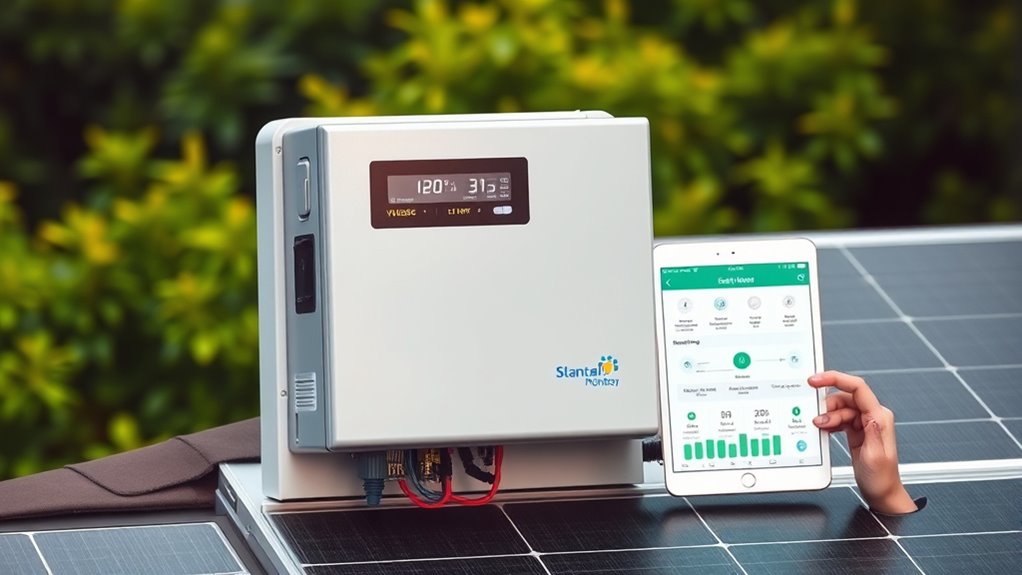
Understanding smart inverter functions is key to managing curtailment effectively. These inverters use local control features like maximum power limit, volt-watt, and frequency-watt settings to automatically adjust power output based on local grid conditions. You can preset curtailment levels at interconnection points or rely on utilities to dynamically modify settings through systems like DERMS or DMS. This setup allows inverters to respond autonomously without needing real-time communication, embedding control directly into the firmware. When grid voltage or frequency exceeds safe thresholds, active power is curtailed to prevent issues like over-voltage or instability. Smart inverter controls enable precise local management of power output, ensuring your solar system operates smoothly within grid limits. Local control capabilities help prevent curtailment penalties and support grid stability, making them essential for effective energy management.
How Local Control Settings Prevent Over-Voltage and Frequency Issues

Local control settings on smart inverters play a crucial role in preventing over-voltage and frequency issues on the grid. They enable your inverter to respond quickly and autonomously to local conditions, reducing the risk of voltage and frequency deviations. These settings include:
- Volt-var control, which absorbs or injects reactive power to keep voltage levels stable.
- Volt-watt control, which reduces active power output as voltage nears limits, preventing over-voltage during high solar input.
- Frequency support, where inverters adjust active power based on local frequency deviations, maintaining system stability.
- Proper calibration of these settings can help prevent repeated issues related to unstable grid conditions.
The Role of Predefined Settings in Minimizing Real-Time Communication

Predefined settings in smart inverters are designed to operate with minimal reliance on real-time communication, reducing delays and potential grid stability issues. By supporting standard protocols like IEEE 2030.5, IEEE 1815, or SunSpec Modbus, inverters can manage basic functions such as monitoring and group adjustments without constant control signals. These protocols ensure interoperability, allowing utilities to set site-specific parameters via scheduled operation modes that specify start times and durations. This pre-scheduling minimizes the need for real-time commands, reducing communication bottlenecks and latency. Additionally, inverters transmit essential telemetry, like voltage, power, and status, at intervals, supporting grid stability and compliance without continuous messaging. High refresh rates in data reporting further enhance the responsiveness and stability of the system. Overall, predefined settings streamline operations, enhance reliability, and prevent unnecessary curtailments.
Strategies for On/Off Solar Curtailment During Negative Feed-in Tariffs
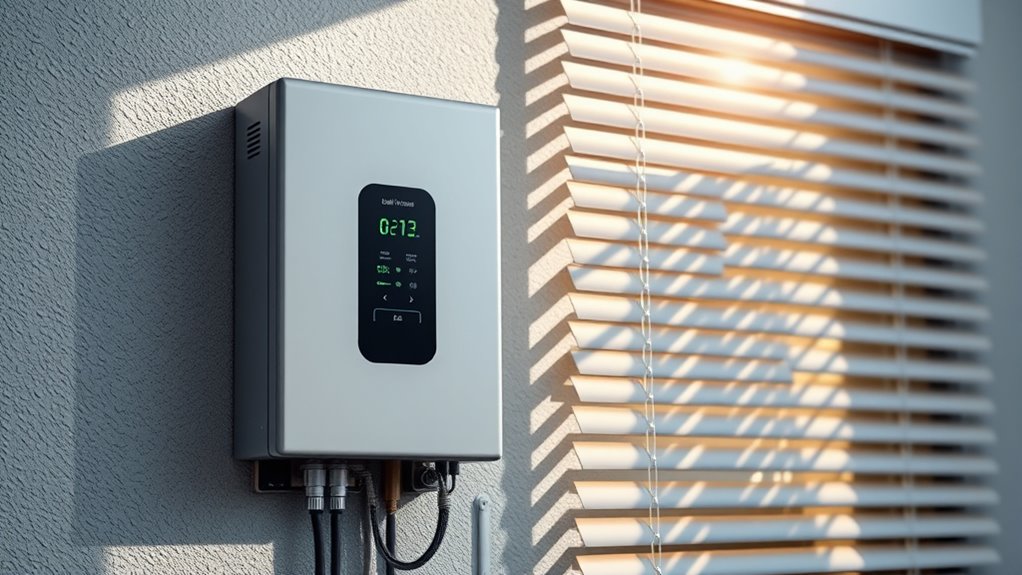
When negative feed-in tariffs (FiTs) occur, effective curtailment strategies help manage excess solar export and protect your system’s financial returns. To do this, you can:
- Use inverter settings to throttle output instead of fully shutting down, balancing self-consumption and export limits. This approach allows for more precise control over energy production during peak times.
- Install battery storage to absorb excess solar energy during negative FiT periods for later use.
- Increase onsite loads through energy management systems, reducing export and maximizing self-consumption.
- On/Off Solar Curtailment involves managing solar energy production during negative FiT periods by temporarily reducing or stopping generation to prevent excess energy entering the grid.
These approaches help avoid penalties while maintaining system performance. Modern inverters can respond dynamically to grid signals, allowing you to adapt output efficiently. Properly managing curtailment ensures you minimize energy wastage and optimize your financial benefits during times of negative FiTs.
Load-Following Techniques to Maximize Self-Consumption and Reduce Penalties
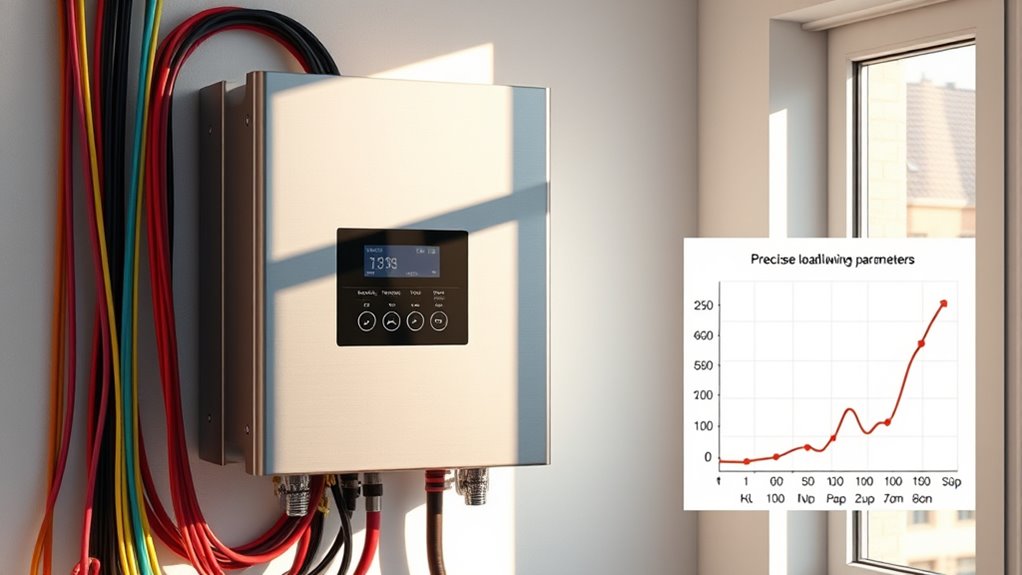
By implementing load-following techniques, you can better match your inverter’s output with your actual energy use, reducing unnecessary grid exports. Smart controls adjust power dynamically, ensuring you maximize self-consumption and avoid penalties. Focusing on ideal energy use helps your system operate efficiently and cost-effectively. Proper system sizing and maintenance also play a critical role in maintaining optimal performance and preventing inefficiencies over time. Additionally, understanding nutritional advantages of green juice can inform energy management strategies by highlighting the importance of balanced resource consumption and sustainable practices.
Dynamic Load Matching
Dynamic load matching actively adjusts inverter output in real time to match fluctuating energy demands within a site. This technique helps you maximize self-consumption of solar energy and reduces reliance on the grid. By integrating smart inverter algorithms with energy management systems, it continuously monitors both solar generation and household loads. To optimize performance, it:
- Uses real-time data to adapt inverter output instantly.
- Employs advanced analytics and predictive tools to forecast demand.
- Shapes load profiles by modifying inverter behavior for grid compatibility.
- Utilizes sophisticated technology for real-time electricity flow control These steps ensure your system responds efficiently to changing energy needs, minimizing excess generation sent to the grid. As a result, you reduce curtailment penalties, extend equipment life, and support grid stability—all while making the most of your solar investment. Additionally, implementing load-following techniques can further enhance system responsiveness and efficiency.
Optimal Energy Use
Optimizing energy use through load-following techniques allows your solar system to adapt dynamically to changing demand and environmental conditions, maximizing self-consumption while minimizing penalties. By adjusting panel tilt seasonally, maintaining cleanliness, and selecting ideal locations, you enhance energy harvest. Smart inverters with MPPT optimize voltage and current, while real-time monitoring detects efficiency drops. Proper inverter sizing and a balanced loading ratio ensure efficient energy delivery. Integrating energy storage captures excess generation and reduces curtailment risks. Control strategies that adjust inverter output in real-time, forecast load, and prioritize critical loads further improve self-consumption. Use the following table to understand key factors influencing load-following:
| Factor | Implementation |
|---|---|
| Seasonal Tilt Adjustment | Change angles seasonally for max harvest |
| Anti-Soiling Maintenance | Keep panels clean to prevent power loss |
| Inverter Sizing & Loading Ratio | Match or slightly undersize panels, optimize load |
| Energy Storage Integration | Pair batteries for peak shaving and dispatch |
| Real-Time Control & Forecasting | Use algorithms for proactive adjustments |
Additionally, understanding the load-following techniques in detail can significantly improve your system’s efficiency and help you avoid penalties.
Coordinated Curtailment to Maintain Grid Stability and Capacity Limits
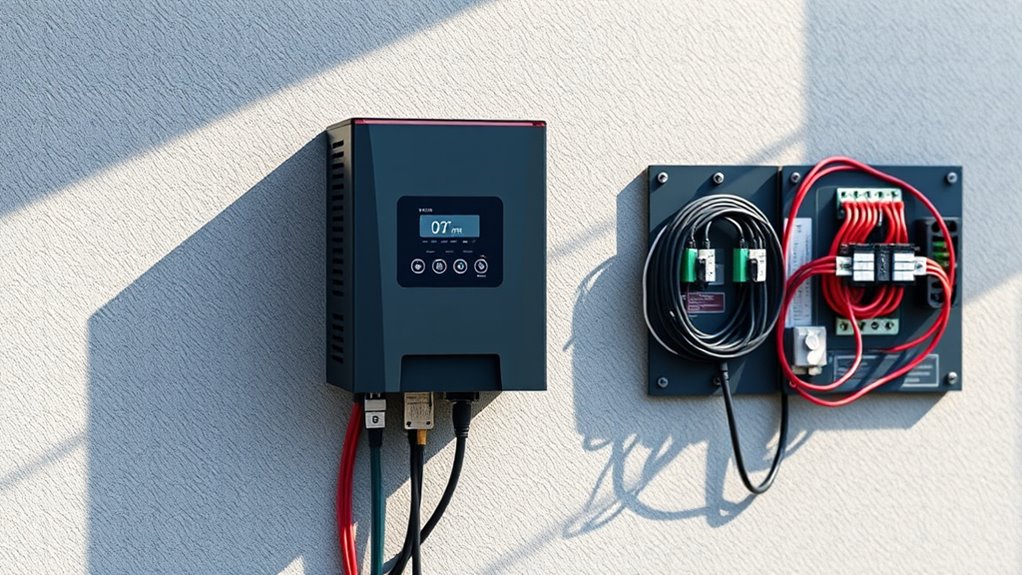
You need to understand how coordinated curtailment helps manage grid capacity and prevent over-voltage issues. Smart inverter settings can adjust renewable output in real time, ensuring stability and avoiding overloads. By working together, these strategies keep the grid reliable and within safe limits. Energy curtailment acts as a safety valve that balances supply and demand, further supporting grid stability during periods of high renewable generation. Additionally, implementing exotic fruit blend inspirations can optimize energy consumption patterns by encouraging the use of renewable sources during peak production times.
Grid Capacity Management
Coordinated curtailment is a critical tool for managing grid capacity and ensuring stability when renewable generation exceeds local demand or transmission limits. It acts as a pressure relief valve, preventing system instability caused by surplus energy. To effectively manage this, you should consider:
- Increasing transmission capacity through grid upgrades or enhancing existing lines to better handle flow.
- Deploying energy storage to shift excess renewable output to peak demand periods, reducing curtailment needs.
- Implementing demand-side management with real-time pricing and demand response to align consumption with variable generation.
– Expansion of transmission infrastructure is essential to accommodate the growing share of renewables and reduce curtailment rates. These strategies allow you to optimize grid capacity, maintain stability, and minimize renewable energy losses while avoiding penalties and ensuring reliable power delivery.
Over-voltage Prevention
How can grid operators prevent over-voltage conditions caused by high renewable generation? By utilizing smart inverters that regulate voltage through reactive power adjustments, you can maintain stable voltage levels. Coordinated curtailment plays a key role, allowing you to temporarily reduce power output when grid conditions threaten over-voltage. Real-time monitoring and advanced communication enable inverters to respond instantly to changing conditions, ensuring effective control. Maintaining proper power factors and integrating with distribution management systems further helps prevent voltage spikes. Smart inverters also provide grid stability services, like voltage support and frequency regulation. Standards such as California’s Rule 21 ensure these systems operate reliably. Smart inverter controls are essential for dynamic voltage regulation and maintaining grid stability. This coordinated approach balances renewable output and grid capacity, avoiding penalties while keeping voltage within safe limits.
Utilizing Volt-Watt and Frequency-Watt Controls for Adaptive Power Management
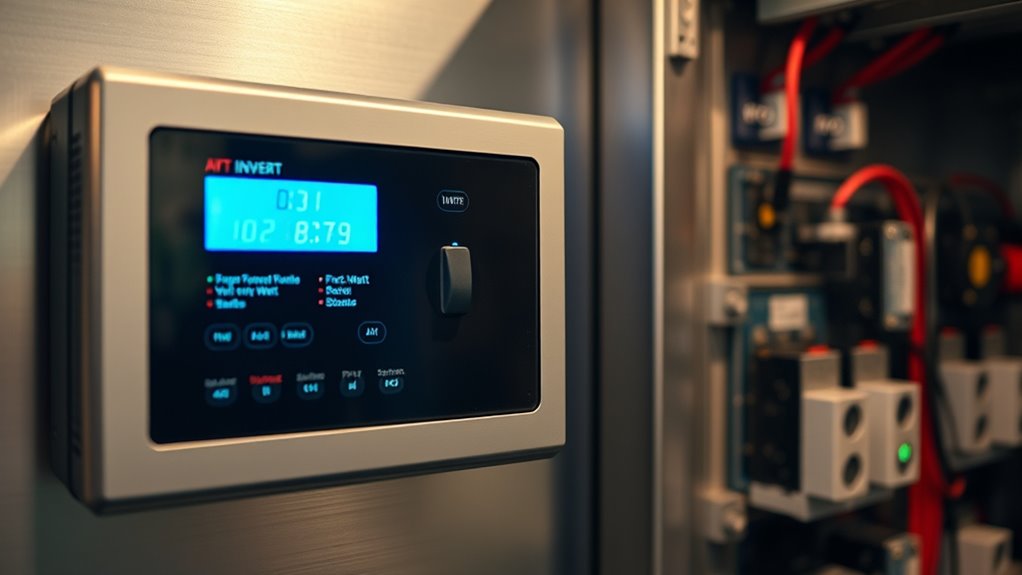
Utilizing Volt-Watt and Frequency-Watt controls enables smart inverters to dynamically adapt their power output in response to grid conditions, enhancing overall stability and reliability. These controls help prevent voltage and frequency issues without needing centralized communication. When voltage exceeds set thresholds, Volt-Watt mode activates to curtail power, thus maintaining voltage stability but potentially reducing solar production. Frequency-Watt adjusts inverter output based on frequency deviations, supporting grid regulation during abnormal events. Combining both controls allows for immediate voltage and frequency response, increasing PV hosting capacity and reducing the need for costly infrastructure upgrades. These features are critical for supporting grid stability as renewable energy integration increases, especially as automation technologies continue to evolve within the energy sector.
Integrating Smart Inverters With Energy Management and Distribution Systems

Integrating smart inverters with energy management and distribution systems enables seamless coordination across your entire energy setup. This integration allows for automated curtailment and optimization, ensuring your system responds efficiently to changing conditions. By connecting these components, you can maximize renewable use, reduce costs, and improve overall system stability. Hybrid inverters play a vital role in this process by converting DC from solar panels into AC power and managing excess energy effectively.
Seamless System Coordination
Seamless system coordination is essential for maximizing the benefits of smart inverters within energy management and distribution networks. It guarantees real-time communication, precise control, and grid stability. Consider these key points:
- You can monitor and adjust energy flows instantly through integration with energy management systems, optimizing consumption and production.
- Smart inverters communicate directly with grid operators, helping balance supply and demand while maintaining voltage and frequency.
- By supporting dynamic grid functions like voltage regulation and reactive power control, they improve feed-in quality and system reliability.
- Proper configuration of inverter settings ensures optimal performance and helps prevent curtailment penalties, enhancing overall system efficiency.
This coordination enables your system to respond swiftly to changing conditions, reduce curtailment risks, and enhance overall efficiency. It’s about creating a synchronized environment where components work together seamlessly for optimal energy performance.
Automated Curtailment Optimization
Automated curtailment optimization leverages smart inverter controls to maximize energy production while maintaining grid stability. By dynamically adjusting active power output based on real-time data, you can improve energy savings and grid reliability. Control strategies like VAR-priority mode favor reactive power, curtailing active power only when PV output exceeds about 80% of the inverter’s capacity. Integrating advanced control systems allows you to optimize PV plant performance, increasing output by up to 3.7%. Independent inverter control at the point of interconnection offers granular management, boosting yields by roughly 1.5%. These systems respect utility ramp rate limits and grid constraints, reducing penalties. Real-time weather data and grid signals enable your inverter controls to optimize curtailment, balancing energy generation with system stability and revenue maximization.
Economic Benefits of Intelligent Export Limiting and Curtailment Optimization
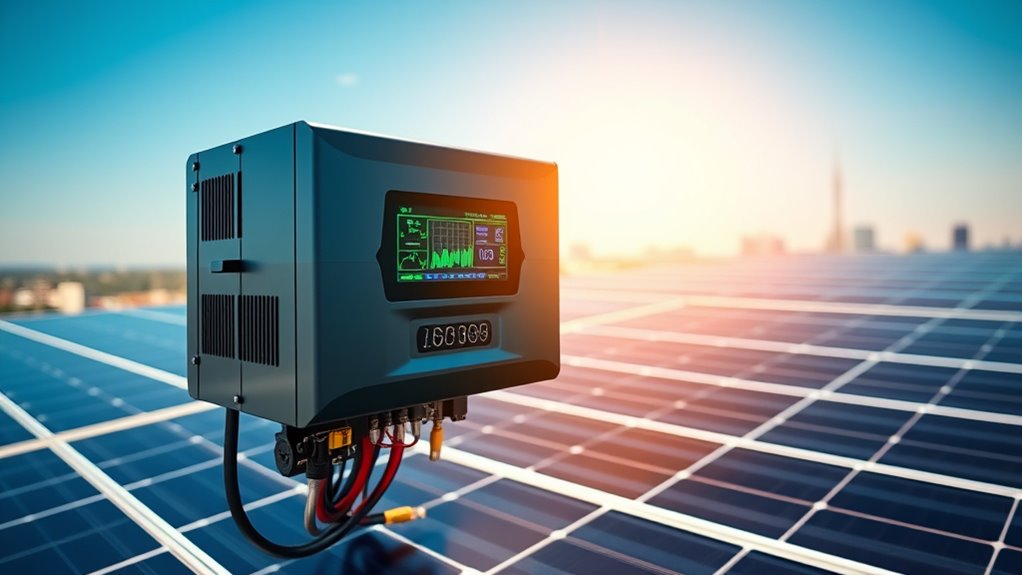
Implementing intelligent export limiting and curtailment optimization delivers significant economic benefits by allowing you to install larger solar systems and maximize energy self-consumption. This approach helps you avoid penalties and enhances your system’s profitability. Here’s how:
- Larger System Capacity: Export limits enable you to install bigger solar setups, increasing energy production and reducing reliance on the grid. This means you can take full advantage of your available roof space and local regulations that permit larger installations.
- Cost Savings: Smart curtailment minimizes grid overloads and voltage issues, lowering maintenance costs and preventing penalties.
- Financial Efficiency: By prioritizing self-consumption and meeting regulatory requirements, your system remains economically viable, even with export restrictions. Proper export management ensures you continue to benefit from the solar energy you generate.
These strategies ensure you get maximum value from your investment while supporting grid stability and compliance.
Best Practices for Configuring Smart Inverter Settings to Avoid Penalties
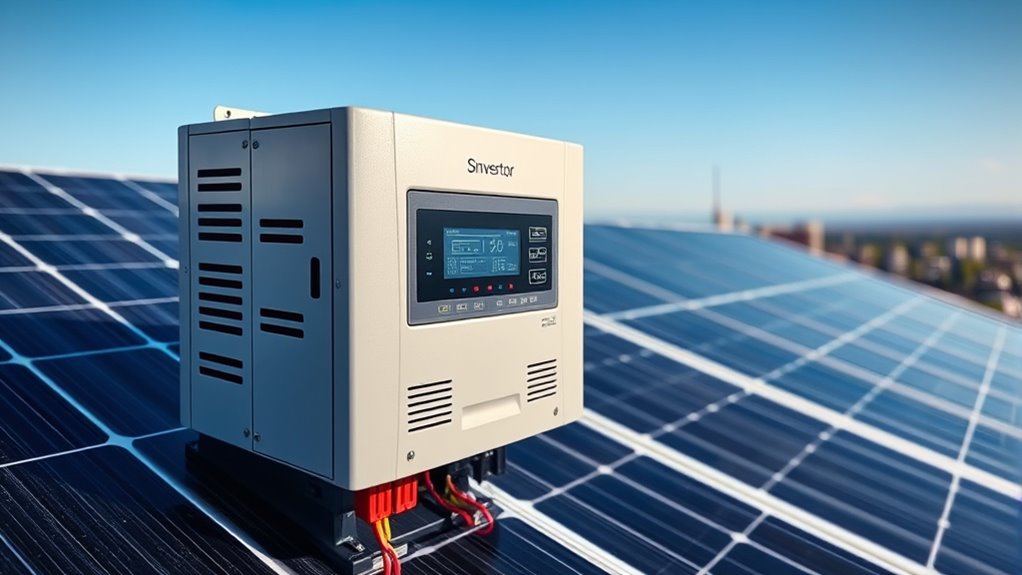
To effectively avoid penalties, it’s vital to carefully configure your smart inverter settings according to utility requirements and grid conditions. Start by adopting IEEE Std 1547-2018 default settings, which are designed to be flexible and future-proof, reducing the need for frequent updates. Focus on volt-var controls that prioritize reactive power management, helping to regulate voltage and prevent overvoltage conditions. Oversizing inverters can also provide necessary reactive support without sacrificing real power output. Regularly monitor performance and adjust settings as needed, especially during changing grid conditions. Coordination with voltage regulating equipment and understanding grid interactions ensures stability. Implementing these best practices helps maintain voltage levels, enhances grid stability, and minimizes the risk of curtailment penalties.
Frequently Asked Questions
How Do Smart Inverter Settings Impact Overall Grid Stability?
You need to understand that smart inverter settings directly influence grid stability by regulating voltage, frequency, and fault response. When configured correctly, they support grid support functions like ride-through capability and dynamic current injection, helping maintain balance and prevent outages. However, misconfiguration or inappropriate settings can lead to instability, voltage fluctuations, or disconnections. Properly optimized settings are essential for ensuring reliable, secure, and efficient grid operation.
Can Inverter Configurations Be Adjusted Remotely After Installation?
Did you know over 80% of modern inverters support remote configuration? You can adjust inverter settings after installation using apps or web interfaces, often through Wi-Fi or cellular connections. This allows you to optimize performance, respond to changing conditions, and avoid penalties without visiting the site. Just make certain your hardware and software are compatible, your internet connection is stable, and security measures are in place to protect your system.
What Are the Key Criteria for Selecting Optimal Curtailment Thresholds?
When choosing ideal curtailment thresholds, you should consider grid stability requirements, inverter capabilities, and local load patterns. Make sure your settings align with regulatory standards and economic goals, like maximizing feed-in tariffs. You’ll also need to account for your inverter’s ability to adjust output dynamically, support load-following strategies, and communicate with the grid. Proper thresholds help you avoid penalties, optimize energy use, and maintain reliable system operation.
How Do Smart Inverter Settings Affect Household Energy Costs?
You might wonder how smart inverter settings influence your energy costs. When properly configured, these settings optimize solar energy use, reduce grid reliance, and prevent unnecessary export of surplus power, which can lead to penalties. By fine-tuning your inverter, you guarantee maximum self-consumption, shift energy use to off-peak times, and avoid costly grid tariffs. This smart management helps lower your bills and increases overall household energy savings.
Are There Specific Standards Governing Smart Inverter Curtailment Functions?
Imagine your inverter adjusting its output as the grid tightens voltage limits—this is governed by standards like IEEE 1547-2018. You need to know that these standards specify how smart inverters must respond to voltage and frequency changes, including curtailment functions. They guarantee your inverter’s actions support grid stability, limit rapid changes, and prevent harmonic distortions, all while aligning with utility regulations to keep your system safe and compliant.
Conclusion
By mastering smart inverter settings, you hold the power to prevent curtailment penalties like a captain steering through stormy seas. With strategic control of voltage, frequency, and load-following, you can navigate the complexities of solar management smoothly. Embrace these best practices, and turn potential setbacks into opportunities for maximizing self-consumption and economic gains. Remember, in the world of solar energy, your proactive approach is the lighthouse guiding you toward peak performance.
I’m Theodore, and I love tiny houses. In fact, I’m the author of Tiny House 43, a book about tiny houses that are also tree houses. I think they’re magical places where imaginations can run wild and adventures are just waiting to happen.
While tree houses are often associated with childhood, they can be the perfect adult retreat. They offer a cozy space to relax and unwind, surrounded by nature. And since they’re typically built on stilts or raised platforms, they offer stunning views that traditional homes simply can’t match.
If you’re looking for a unique and romantic getaway, a tree house tiny house might just be the perfect option.
